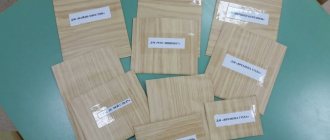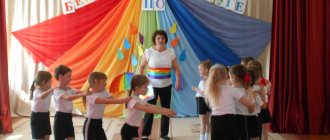Topic: Outdoor games: “Polar bears”. "Cosmonauts". Relay races. Development of speed and strength qualities
1.Game "Empty Space"
Preparing for the game.
Choose one driver. The players, with the exception of the driver, stand in a circle at a distance of no more than half a step from one another, with their hands behind their backs. The driver stands behind the circle.
Game description
. The game begins as directed by the teacher. The driver runs in a circle, touches one of the players and after that continues to run around the circle in one direction or another. The player he touched runs around the circle in the opposite direction, trying to run to his place faster than the driver. Which of them will take the empty seat first? Whichever of them takes the empty seat first, stands there, and the one left without a seat leads.
Rules of the game.
The driver has the right to touch with his hand only the player whom he challenges to the running competition. When the players run around the circle, no one should interfere with them. While running around the circle, the players do not have the right to touch those standing in the circle. When meeting, players must stay to the right.
Methodical instructions.
Students should be told not to challenge the same players to a running competition. To make it easier to remember who has already run, after running, keep your arms along your body. If there are a large number of areas, you can build 2-3 circles, each circle working independently.
Game options.
1. Running around the circle and meeting on the way, both players shake each other with their right hand or crouch.
2. When they meet on the way, they turn around, sit on the floor, stand up, and clap their hands.
3.Buildings can be very diverse. Anyone who fails to complete the task becomes the driver.
2.
Game “Polar Bears”
Preparation for the game.
The site is marked with 12*12m lines. To the side of the site they limit a small place - an ice floe. They choose two drivers - polar bears, who stand on the ice floe. The rest of the players are bear cubs, they are placed randomly around the court.
Description of the game.
At the teacher’s signal, the polar bears, holding hands, run out from the ice floe and begin to catch the cubs. Having caught up with someone, polar bears try to connect their free hands so that the player they overtook ends up between the hands. The polar bears take the caught player behind the ice floe, and they themselves go fishing again. Having caught another bear cub in the same way, the polar bears take it to the ice floe. When there are two caught on the ice floe, they also join hands and begin to catch the cubs. The game continues until all the cubs are caught. The player caught last is considered the most dexterous and next time becomes a polar bear, choosing any of the players as his mate.
3.
Relay races
Safety briefing.
1) “Rubber Ball Relay”
Station "SOOBRAZHAIKA"
Leading:
— Before you solve the riddles and complete the task at this station, you need to put on your “thinking cap.”
Children imitate movements, as if they were putting a hat on their head, and begin to massage their ears, wrap and unfold their lobes.
Space mysteries
The clear firmament is beautiful, There are many fables about it. They won’t let you lie to me, It’s as if animals live there. There is a predatory beast in Russia, Look - it’s in the sky now! On a clear night it glows - Big...(Ursa).
And the bear is with her child, a kind, nice little bear. Little... (Ursa) glows next to her mother.
Planet with a crimson tint. In military paint, boastful. Like pink satin, the planet glows... (Mars).
A bird cannot fly to the moon and land on the moon, but a fast one can do it... (rocket).
Relay "Builders"
Leading:
Two teams of 9 people each take part in the relay.
— Whose team will build a spaceship out of geometric shapes faster?
(According to the diagram: the base of the rocket is made up of 2 rectangles. 3 cubes are placed above the rectangles, 2 more cubes above them, 1 cube above them and a cone on top)
Leading:
They did an excellent job. The rockets are excellent, ready for launch.
And we are heading to the next station. (children read)
And our next relay race is called...
Relay race “Space tourists”
Two teams of 8-9 people play.
You need to transport passengers to a distant planet while listening to music. They carry passengers in a hoop - running in pairs. The team that transports passengers the fastest wins.
Leading:
Astronauts must be very careful. Now we will check whether our astronauts are attentive.
Game "Confusion: Jump and Leap"
Leading:
- Let's test your playful, jumping, jumping energy and cosmic attentiveness! If I shout: “Jump,” then you, jumping, loudly and unanimously respond: “Jump!” And if I shout: “Jump!”, then you all jump up and answer: “Jump.” Do you remember? Begin!
Leading:
You cope well with complex tasks. It's time for us to go to the next station. (children read)
Station "TRAINING"
Leading:
- Don't yawn around! You are an astronaut today! Let's start training to become strong and agile.
General developmental exercises
Rockets fly up - arms through the sides up, claps 3 times above your head - 6 times.
Rocket in space - feet shoulder-width apart, arms straight above your head, palms clasped. We bend to the right-left-back-forward - 6 times. The astronauts put on a spacesuit and fly into outer space - an imitation of putting on a spacesuit. Flying in zero gravity is an exercise in balance. Hands to the side. We alternately raise our legs, bent at the knees - 6 times. We quickly spin around in place, holding our arms to the sides, and stop at the stop signal with our eyes closed. Who will be able to maintain balance longer than others? Repeat 2 times. Leading:
We trained the body, we train attention.
Exercise for attention
Lazy eights - we make eights with our hands in the air.
The right hand makes circles to the left, the left – to the right. The right hand draws a triangle in the air, and the left hand draws a circle. The right leg draws squares in the air, and the left hand draws triangles. Host: We had a great workout. Let's go to the next station. (children read)
To space with children! A selection of amazing space-themed games to play at home
How can you tell your child about space in an accessible way? Of course, in a playful way. We offer a selection of amazing space-themed games to play at home.
First of all, we enter the space school, because, you know, whoever gets into the astronauts is not accepted. What should every astronaut know and be able to do?
The structure of the Earth and the Universe is basic knowledge, let’s start with it. It’s very easy and accessible to tell kids about this in a simple playful way - we’ll make a model of our planet (inner core, outer core, mantle and crust), as well as the cosmos itself (more precisely, a piece of it), arrange the stars, and arrange our luminary in the middle - the Sun and around it are all the planets of our system, for each planet we draw an orbit, simultaneously explaining what it is.
In such a game it is easy to talk about the cosmic structure, the names of the planets, to fantasize about whether there is life somewhere else besides Earth and what this life is like.
An empty box, a garland and a switched off light will help you see the constellations in your own room. We make small holes in the box so that the garland bulbs can be placed in them and, according to the diagrams (which are easy to obtain on the Internet), we lay out (or rather stick in the bulbs) the constellations we need. Children will listen and participate with much more interest if, for example, they are told about their constellations (Aries, Taurus, etc.). How did it appear, why was it called that way and not otherwise.
Let’s not forget about everyday questions - how do astronauts eat in space? This topic always arouses interest. We created our own space menu. They put jelly and fruit puree into ziplock bags and felt almost like real astronauts.
The only thing we lacked for complete happiness was the space flight itself. But this turned out to be not a problem.
Lego figures are us - dad, mom, children. We put on spacesuits, the role of which is played by foil. Children cope with this quickly. The only things missing are rockets, Lego bricks with a countdown and “puuuuck!” and here it is - endless space.
And first of all, we will fly to our faithful satellite, to the Moon.
To help children navigate the distance from the Earth to the Moon, we can give several examples. To fly to the Moon by plane, it will take about 20 days, by car at a constant speed of 90-100 kilometers per hour - up to six months. HALF A MONTHS!
One of the most amazing and at the same time most dangerous things on the Moon is lunar dust. As everyone knows, sand penetrates everywhere on Earth, but dust on the moon is an extremely dangerous substance: it is fine, like flour, but at the same time very rough. Thanks to its texture and low gravity, it penetrates absolutely anywhere.
The role of lunar dust was played by rye flour, placed in a container and provided to the children for study. And we finally corrected the historical injustice - we placed the flag of the Russian Federation on the lunar surface (she said that the first and only ones who landed on the Moon were American astronauts).
NASA had numerous problems with lunar dust: it ripped astronauts' boots almost completely apart, penetrated ships and space suits, and caused "lunar hay fever" in unfortunate astronauts if they inhaled it. It is believed that with prolonged contact with lunar dust, any, even the most durable object can break.
They cleaned astronauts and spaceship elements from lunar dust, left marks from asteroids (throwing stones into flour), buried and dug up their arms, legs, astronauts and in general everything that was nearby. There is a version that flights to the Moon stopped because the astronauts met SOMETHING there that scared people. Something inexplicable. As Neil Armstrong said, “We were given the impression that the place was taken.” Well, my astronauts discovered SOMETHING - with many eyes, making strange sounds.
We discovered this and quickly shot into the rocket. We flew on.
And now we have arrived to our sister planet, Venus. Earth and Venus have a lot in common; they are the same in size.
The role of Venus was played by a box of soda. There are many craters on the surface of Venus, scientists believe that Venus was formed mainly after volcanic processes, due to a large number of volcanic eruptions, lava spills, the formation of craters and mountain ranges on the surface of the planet.
The pale yellow clouds that surround the planet contain droplets of sulfuric acid that fall on Venus in acid rain. The children first filled the craters with soda, and then poured colored water with citric acid on top. This was our acid rain. There was a stormy reaction, which greatly delighted the young cosmonauts.
Venus, the brightest of the planets. It shines so strongly that on a moonless night it can easily cast a shadow on the Earth. And it is also perfectly visible even without special equipment, the brightest star to the left of the Moon.
When our Venusian life ended, we boarded our rocket again and set off today for Mercury.
Mercury is a rocky planet; as the planet's core cools and contracts, Mercury's surface becomes wrinkled. Scientifically, these wrinkles are called “scarps.” Scarps can be very high and reach several hundred kilometers.
For us, the role of Mercury was played by a container with oatmeal; we placed a switched-on garland under the container and the look was truly not earthly.
There is no evidence of life on Mercury. Daytime temperatures can reach 430 degrees Celsius and drop to -180 degrees Celsius at night. It is unlikely that life as we know it could survive on this planet.
But oddly enough, it was we who witnessed the existence of this very incredible life. Yes, yes, we met THEM - aliens.
It's amazing how the human brain works - everything we come up with we have seen or heard somewhere and once. So it’s difficult to come up with this without relying on anyone’s experience, but simply out of thin air. But children succeed in this as well as possible.
- What if the planet where aliens live doesn’t need eyes? - the children decided.
“How are they not needed?” I ask. “How will they look?”
- There’s nothing to see there. “There’s nothing interesting there that needs to be looked at,” came the answer.
A child’s imagination has come into play, something you can’t keep up with. The children created something extraterrestrial. An alien without a body. Yes, he doesn’t need it. In addition, as my daughter stated, there is no gravity on the planet where it lives, and therefore this alien must be sticky in order to have good adhesion to the soil.
And there are no eyes or mouth, let alone ears and nose. But if you put eyes on it, it can see, if you put ears on it, then it can hear, and it speaks with the help of thoughts. And it takes the form of the vessel in which it is placed.
Our alien was made of paste and borax (sodium tetroborate, which is sold in any pharmacy), had a viscous structure, but almost did not stick to your hands.
His eyes grew larger and smaller, his legs, arms and other protruding parts of his body periodically appeared, and sometimes his heart and kidneys could be seen. And a bunch of other organs for which the children, of course, came up with names, but due to the difficulty of pronunciation, I will not be able to reproduce them (and the children forgot after 5 seconds what they just came up with).
When it became clear that the table was no longer enough for them and soon all this disgraceful splendor would be on the floor and walls of the kitchen, I brought a large plastic container. The daughter took out silicone baking molds, which immediately turned into UFOs, our disembodied comrades plunged into them and set off to fly across the Galaxies. With the addition of water, the molds slid along the bottom of the container as if on ice.
This is where I’ll probably end the story about our space travels. As can be seen from the above, flying into space is available to everyone, even without leaving your apartment.




